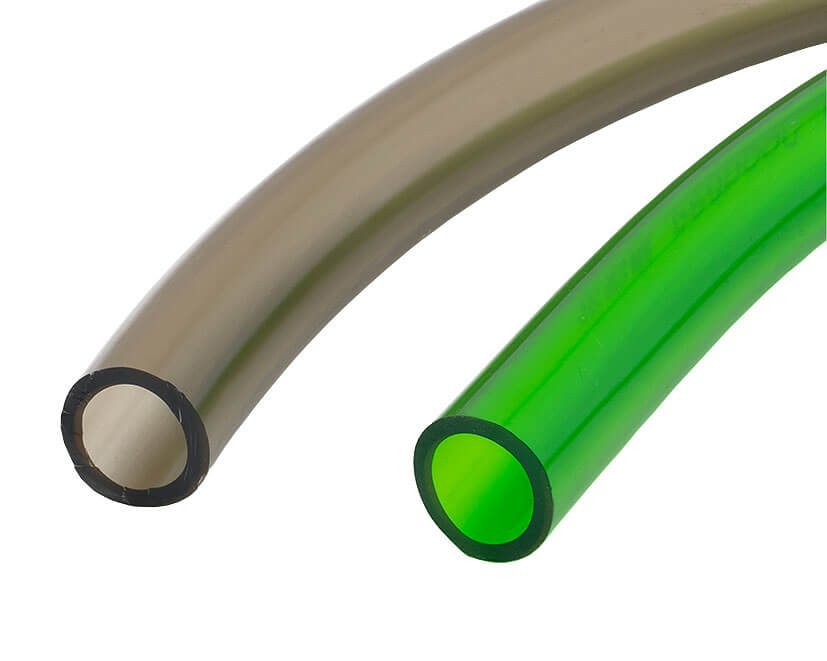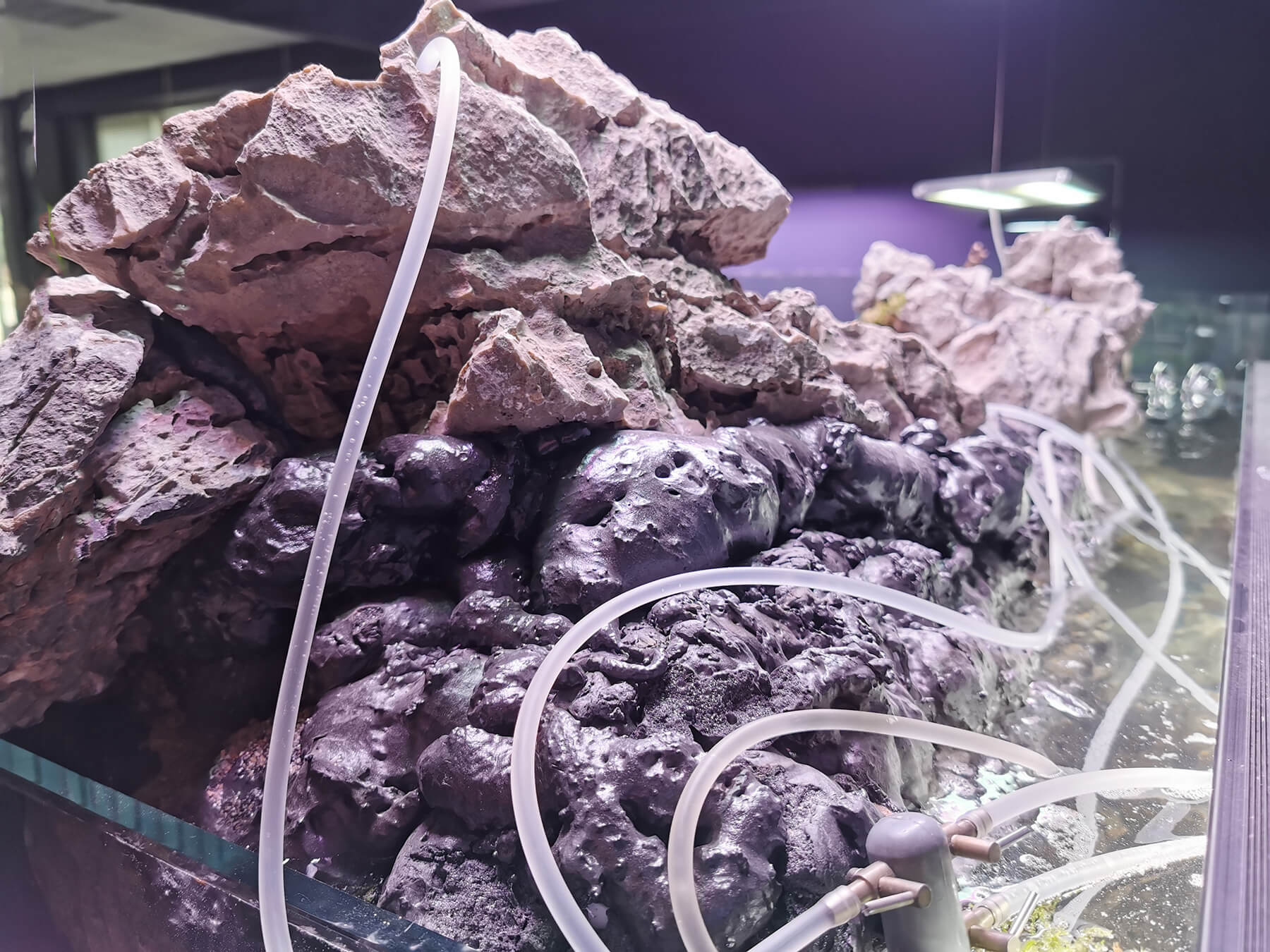Aquarium hoses and their use in aquaristics
Table of contents
12/16, 4/6, silicone, PP, 9/12, 16/22, green, gray, transparent, ... what does this tell us? For all of you, who are literally standing on the hose when it comes to hoses for the aquarium, here is a small attempt to give you an overview of the aquarium hoses commonly used in aquaristics and to literally unravel the tangle of hoses.
Hose diameter
Aquarium hoses always have two numbers, separated by a slash. The first, smaller number indicates the inner diameter of the hose in millimeters, the second the outer diameter. So a 4/6 mm air hose has an inner diameter of 4 and an outer diameter of 6 mm. Knowing the inner diameter is interesting when buying hoses for specific connections, for example, from an air pump or an internal filter. Also, diffusers or diffusers often have a connection diameter specified so that you can buy the appropriate hose for them.
Suitable diameter of aquarium hose and connection
Often, especially in the case of terminal devices such as diffusers, diffusers or filter inlets, the connection is one millimeter thicker than the hose - this is done so that the hose sits really tightly on the connection and does not slip off. Under no circumstances should you buy a larger hose in such a case!
Convenient mounting of aquarium hoses
Especially with glassware , the attachment of aquarium hoses is quite tricky, so that you do not provoke glass breakage. But even with connections made of plastic, it can be quite annoying to push on the stubborn hose. Fortunately, there is a very simple trick here: Every hose for the aquarium becomes softer through heat. If you put the end that you want to slide onto the filter, CO2 diffuser, filter inlet or filter outlet or similar hose connections in a cup of hot water for a few minutes before fitting it, it becomes much more flexible and softer. So you can make the hose assembly on the aquarium much easier. If you now rub the connection on the device or accessory with a mixture of hand dishwashing detergent and water, the hose end will slip even a little better. Once the hose has cooled down and the water has dried up, the hose connection is bomb-proof.
Many devices also come with a hose clamp. This should be used and tightened according to the manufacturer's instructions.

A little material science
Polyvinyl chloride / PVC
As a rule, filter bags and air hoses are made of inexpensive phthalate-free and cadmium-free polyvinyl chloride or PVC. Depending on the manufacturer, the filter bags are slightly harder or slightly softer. As a rule, the filter bags are sold rolled up and sometimes retain this shape even after installation. Especially the thicker filter bags like to be a bit stubborn. Over time, however, they stretch themselves. You can speed up the process somewhat by heating them.
Aquarium hoses made of PVC do not release anything into the water and therefore behave water-neutrally at the aquarium. Mostly PVC aquarium hoses are transparent green, transparent gray or (more rarely) transparent. PVC aquarium hoses usually do not have a fabric insert and are suitable for transporting air as well as water. They can be used as filter hoses, air h oses or even for sucking the aquarium water during water change. Aquarium hoses made of PVC are not gas-tight and not particularly pressure-resistant, so they are not suitable for use with a pressurized gas system forCO2.
Especially thin PVC aquarium hoses can tend to compress when running over an edge such as a thin pane of glass. Therefore, for routing over edges, we strongly recommend the use of a U-shaped tubing guide into which the tubing is placed to keep it from compressing.
Silicone
Flexible silicone hoses for aquariums are more expensive than hoses made of the rather inexpensive PVC, but they are also less stubborn. Transparent silicone hoses for airorCO2 can be used to make connections in the aquarium much more inconspicuous than the colored PVC aquarium hoses. Since silicone is slightly softer than PVC, connecting glassware with silicone tubing is much less risky and easier. Silicone is not really gas-tight either, so use silicone tubing forCO2 really only on the last stretch to the aquarium and not for the entire length of tubing from the pressure reducer of theCO2 system to the diffuser in the aquarium.
Also the flexible silicone hoses can compress when running over thin edges. Here, we also recommend the use of an appropriate hose guide so that the performance of the aquarium hose is not impaired.
Gas-tight, pressure-resistant plastic
CO2 hoses, on the other hand, are made of a gas-tight, pressure-resistant plastic that does not allow even the smallCO2 molecules to pass through. This plastic is extremely stubborn and kinks very easily, especially over edges - then theCO2 hose is unusable because it then leaks and can even tear further. This can be prevented either with a hose guide or even with a specially shaped connector made of glass, stainless steel or gas-tight plastic.
CO2 hoses are often black or green, but they also come in other colors and even transparent.
CO2 tubing is difficult to mount on glassware because of its extreme rigidity. Therefore, for the last stretch in theCO2 supply, people often choose an appropriate silicone hose to connect the high-quality and expensive glassware.

The common types of hoses on the aquarium
Filter hoses
Filter hoses for connecting the external filter to the aquarium are mostly made of the somewhat cheaper PVC, now and then also of the more expensive silicone. They are often inconspicuous transparent green or transparent gray, now and then you can find a completely transparent variant. Over time, algae deposits and bacterial films can form on the inside of the filter bag, so completely transparent filter bags for aquariums quickly look very unattractive. If the coating on the inner wall of the hose is so thick that the filter performance suffers, the filter hose should be cleaned with a special long hose brush. Then the deposits are gone and the filter can do its work again.
Filter hoses are available in different diameters, so please always buy one that fits the connection size of the filter! Common sizes are 9/12 mm, 12/16 mm and 16/22 mm. But also thicker aquarium hoses with 31/40 mm are available. You need them for pond filters, for example.
However, filter hoses can be used not only to connect the external filter, but also for all kinds of other purposes. A 9/12 mm or 12/16 mm thick hose, for example, is also practical for the weekly water change - with it you can easily suck the water out of the aquarium, but it is not so big that larger aquarium fish can slip through it. If, on the other hand, shrimp or nano fish live in the aquarium, the filter hose should be secured with a piece of filter sponge or a nylon sock so that no small animals are sucked out with the aquarium water.
PVC or silicone filter tub ing is also excellent for connecting other aquarium accessories such as a UV-C clarifier.
Air hoses
Air hoses are usually made of transparent silicone or transparent green or gray PVC. They have a diameter of 4/6 mm and are suitable for operating an air pump and an outflow stone.
By the way, an air hose in connection with a thin wooden stick (shish kebab stick or plant support stick) can be used to make an excellent suction device for the aquarium floor: Tie the air hose to the stick so that the tip protrudes a few centimeters beyond the end of the hose. The air hose should not be compressed! Now you can carefully poke through the substrate with the tip and use the hose to suck up the mulm stirred up in this way. Since the hose is very thin, there is little danger for baby shrimp.
CO2 hoses
CO2 hoses are relatively rigid and kink very easily. But they are pressure resistant and gas tight! They do not allow even the very smallCO2 molecules to diffuse through their wall, as would be the case with silicone or PVC, and they withstand the high working pressure from the pressure reducer of the CO2 system without tearing.
Classic CO2 hoses are green or black, but they now come in other colors as well. Especially if you want to operate more than one aquarium with a CO2 system, it is advisable to use different hose colors - this makes the tubing behind the aquariums much clearer!
When laying theCO2 tubing and mounting it to the connections of the equipment and accessories, you must take good care not to kink theCO2 tubing.CO2 hose guides and gas-tight spacers help here.
CO2 hose and glassware are often not a good combination - too often there is glass breakage when the stubborn, stiff hose is to be mounted on the good pieces. For this reason, it is often preferable to choose the less gas-tight but more flexible and easier-to-process transparent silicone hose for connection to the expensive, high-quality glassware.
